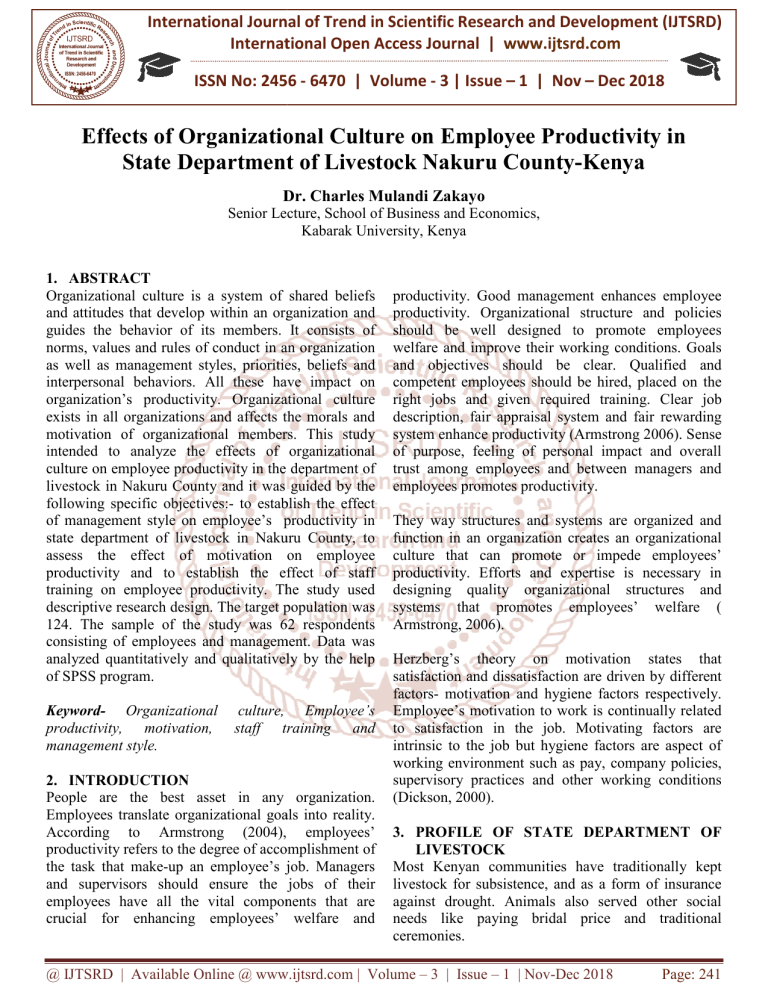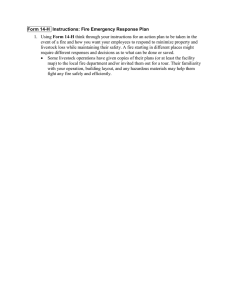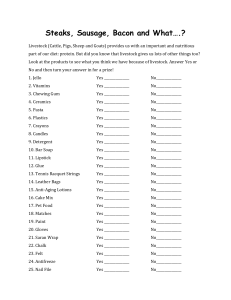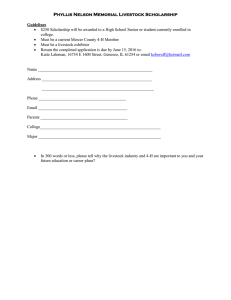
International Journal of Trend in Scientific Research and Development (IJTSRD)
International Open Access Journal | www.ijtsrd.com
ISSN No: 2456 - 6470 | Volume - 3 | Issue – 1 | Nov – Dec 2018
Effects of Organizational Culture on Employee Productivity in
State Department of Livestock Nakuru County-Kenya
County
Dr
Dr. Charles Mulandi Zakayo
Senior Lecture, School of Business and Economics,
Kabarak University, Kenya
1. ABSTRACT
Organizational culture is a system of shared beliefs
and attitudes that develop within an organization and
guides the behavior of its members. It consists of
norms, values and rules of conduct in an organization
as well as management styles, priorities, beliefs and
interpersonal behaviors. All these have impact on
organization’s productivity. Organizational culture
exists in all organizations and affects the morals and
motivation of organizational members.
bers. This study
intended to analyze the effects of organizational
culture on employee productivity in the department of
livestock in Nakuru County and it was guided by the
following specific objectives:- to establish the effect
of management style on employee’s
oyee’s productivity in
state department of livestock in Nakuru County, to
assess the effect of motivation on employee
productivity and to establish the effect of staff
training on employee productivity. The study used
descriptive research design. The target
get population was
124. The sample of the study was 62 respondents
consisting of employees and management. Data was
analyzed quantitatively and qualitatively by the help
of SPSS program.
Keyword- Organizational
productivity, motivation,
management style.
culture, Employee’s
staff training and
2. INTRODUCTION
People are the best asset in any organization.
Employees translate organizational goals into reality.
According to Armstrong (2004), employees’
productivity refers to the degree of accomplishment of
the task that make-up
up an employee’s job. Managers
and supervisors
ervisors should ensure the jobs of their
employees have all the vital components that are
crucial for enhancing employees’ welfare and
productivity. Good management enhances employee
productivity. Organizational structure and policies
should be well designed
igned to promote employees
welfare and improve their working conditions. Goals
and objectives should be clear. Qualified and
competent employees should be hired, placed on the
right jobs and given required training. Clear job
description, fair appraisal system
stem and fair rewarding
system enhance productivity (Armstrong 2006). Sense
of purpose, feeling of personal impact and overall
trust among employees and between managers and
employees promotes productivity.
They way structures and systems are organized and
an
function in an organization creates an organizational
culture that can promote or impede employees’
productivity. Efforts and expertise is necessary in
designing quality organizational structures and
systems that promotes employees’ welfare (
Armstrong, 2006).
Herzberg’s theory on motivation states that
satisfaction and dissatisfaction are driven by different
factors- motivation and hygiene factors respectively.
Employee’s motivation to work is continually related
to satisfaction in the job. Motivating factors are
intrinsic to the job but hygiene factors are aspect of
working environment such as pay, company policies,
supervisory practices and other working conditions
(Dickson, 2000).
3. PROFILE OF STATE DEPARTMENT OF
LIVESTOCK
Most Kenyan communities have traditionally kept
livestock for subsistence, and as a form of insurance
against drought. Animals also served other social
needs like paying bridal price and traditional
ceremonies.
@ IJTSRD | Available Online @ www.ijtsrd.com | Volume – 3 | Issue – 1 | Nov-Dec
Dec 2018
Page: 241
International Journal of Trend in Scientific Research and Development (IJTSRD) ISSN: 2456-6470
2456
With the arrival of the western culture and gradual
interaction with the global economy, livestock trade in
Kenya picked more economic importance. The
organization of livestock subsector started in 1898
with the creation of the veterinary department headed
by the veterinarians in the British Army. 1n 1987, the
department of livestock
vestock production was created. Prior
to 1980, the livestock sub-sector
sector was under the
mandate of the Ministry of Agriculture but thereafter
the ministry of livestock development was created.
The existing national livestock department policy was
developed in 1980 and its objectives were: to address
the high poverty incidence, enhance foreign exchange
earnings and food security, to emphasize on
sustainable use of environment and provide raw
materials for both processing and manufacturing
industry.
4. STATEMENT OF THE PROBLEM
Achievement of high level employees’ productivity in
an organization would be crucial for the overall
productivity and profitability of an organization. Most
organizations have not embraced proper management
of human resources in order to achieve
chieve high levels of
productivity in employees. Organizational culture
influences productivity in many ways. Many
organizations in public sector have not been able to
organize their employees to produce as much as
possible and help the organization and in
individuals
accomplish their objectives. This study aimed at
assessing the effects of organizational culture on
employee productivity in the state department of
livestock- Nakuru County.
General objective
The purpose of this study was to examine the effect of
organizational culture on employees’ productivity in
the state department of livestock Nakuru County
County.
Specific Objectives
1. To establish the effect of management style on
employee productivity in the state department of
livestock Nakuru-Kenya
2. To assess the effects of motivation on employee
productivity in the state department of livestock in
Nakuru County Kenya.
3. To establish the effect of staff training on
employee productivity in the state department of
livestock Nakuru County Kenya.
Scope of the study
The research focused on the effects of organizational
culture on employees’ productivity in the state
department of livestock in Nakuru County. It zeroed
to management style, motivation and staff training
and their effects on employees’ productivity.
5. LITERATURE
ERATURE REVIEW
Theoretical reviews
According to Edgar Shein (1992) model of
organizational culture, there are mechanisms that
direct and indirect influence organizational culture;culture;
Organizational culture is directly influenced by
motivation, behavior, status of the staff and opinions.
It is also indirectly influenced by management style,
mission and vision of a company, rules and
regulations, corporate identity rituals and designs.
CHARLES HANDY (1985) MODEL FOR
CULTURE
Dif
Kinds of
Charles Handy Outlined Four Different
Culture Which Includes:-- power culture, role
culture, task culture and person culture. Power culture
is where power is held just by a few individuals
whose influence is felt in the whole organization.
Role cultures are based on rules. All the staff are
expected to know their roles and responsibilities.
Power in a role culture is determined by a person’s
position in the organization hierarchy.
Task culture: this is formed when teams in an
organization are formed to address specific problems
problem
or project progress. In this culture the task at hand is
the most important thing therefore power keeps
shifting depending of the mix of the team members
and the status of project being handled.
Person culture: this culture has employees who see
themselves
ves as unique and superior to the organization
and other colleagues and their major purpose is to
work.
Deal and Kennedy’s (1982) model for organization
culture
This culture is based on staff training, feedback and
reward after they have done something. Action plans
and corrective measures are effective when feedback
is provided immediately leading to effectiveness and
existence of a constant culture
@ IJTSRD | Available Online @ www.ijtsrd.com | Volume – 3 | Issue – 1 | Nov-Dec
Dec 2018
Page: 242
International Journal of Trend in Scientific Research and Development (IJTSRD) ISSN: 2456-6470
2456
Deal and Kennedy (1982) outlined four cultures:
cultures:Work-hard, play-hard
hard culture: Here employees need
immediate feedback and they have to maintain high
levels of energy.
Process culture: This culture has slow feedback and
low risk resulting to low stress, slow worki
working,
relaxation and security at work and it takes long to
find out whether the decision is right or wrong.
Bet-your company: Here, decisions are high risk but
employees may wait for long before they know
whether their actions are right or wrong.
Tough-guy macho: this culture contains a world of
individuals who enjoy risk and who get quick
feedback on their decisions. Here employees enjoy
excitement and work hard to be stars.
MANAGEMENT STYLE
According to Armstrong (2003) the management style
plays a vital role in developing and implementing
organizational transition and ensuring that procedures
for carrying out change assessment, audits and
inspections are implemented. Management styles have
the duty of monitoring and evaluating transition and
taking corrective
ctive actions where necessary. Managers
are responsible for ensuring that employees are
conscious of the likely changes that may take place
within the organization. Manager has two fold, first
the employee must know what to do and secondly this
knowledge must
ust be translated into action following
the transition that has taken place within the
organization (Chopra, S, & Clara 2004). Management
must ensure that the style it employs complies with
laid down working procedures.
Haroold et al (2005) noted that management
agement style has
to operate on two fronts regarding how to implement
transition measures in the workplace. Making work
better for its employees and ensuring appropriate
working condition. According to Armstrong (2006)
management style of any industry shou
should support the
implementation of transition policies, communicate
the need for good aligning of change practices,
provide a systematic risk assessment, ensure that the
change policies are investigated thoroughly, record
data on transforming of existing rules
es and procedures
which are used to evaluate performance and initiate
action.
MOTIVATION
Motivation is the driving force by which humans
achieve their goals. Motivation may be rooted in a
basic need to minimize physical pain and maximize
pleasure (Armstrong
strong 2002). Intrinsic and extrinsic
motivation: Intrinsic motivation refers to motivation
that is driven by an interest or enjoyment in the task
itself, and exists within the individual rather than
relying on any external pressure. Extrinsic motivation
comes
omes from outside of the individual. Common
extrinsic motivation are:- Rewards like money,
coercion and threat of punishment. Extrinsic
motivation can be internalized by individuals if the
task fits with their values and helps to fulfill their
basic psychological
ological needs (McCarthy 1994). Drives
and desires can be described as deficiency or needs
that activates behavior that aim at a certain goal.
These originate from within the individual and may
not require external stimuli to encourage the behavior.
Basic behavior can be sparked by deficiencies such as
hunger which motivates a person to seek food, desire
for praise or approval which motivates a person to
behave in a manner pleasing to others (Chandra
2006). Extrinsic motivation is simply what is done to
or for people to motivate them for example, pay
increase, praise, promotion and punishments.
Hangman (2005) observed that if we do something it
will lead to another. People work for money.
Drummond (2001) observed that people can be
conditioned to act in certain
tain ways if they are rewarded
for behaving as required.
Training
Training is the process of increasing the knowledge
and skills of employee for doing particular job. It is an
organizational activity designed to create the thinking
and behavior of people and enable them to do their
jobs in more efficient manner. It implies imparting
technical knowledge and manipulative skills of
problem solving and positive attitudes and developing
an individual in all aspects. Organizations make
arrangement for the development
opment of their staff so as to
improve the efficiency of management and workers.
Individual workers and organizations benefit from
training through job satisfaction which gives an
employee confidence in handling the job assigned to
him, thus resulting to self
elf esteem and job security
which leads to commitment to the organization. Also
reduces accidents, spoilage of machines, reduces
complaints and brings about better use of resources
and brings good interpersonal relationships (Bally,
2008)
@ IJTSRD | Available Online @ www.ijtsrd.com | Volume – 3 | Issue – 1 | Nov-Dec
Dec 2018
Page: 243
International Journal of Trend in Scientific Research and Development (IJTSRD) ISSN: 2456-6470
2456
Effective training
ng minimizes learning costs, improves
individual, team and corporate performance in terms
of out-put,
put, quality, speed and overall productivity.
Training is the corner stone of sound management for
it makes employees to be more effective and
productive. Training
ning is a widely accepted problem
solving device. (Armstrong 2003).
Critical review
The management style of industry should support
enhancement of productivity in the organization.
Should communicate the need for good alignment in
change practices, provide systematic risk assessment,
ensure that the change policies are investigated
thoroughly and ensure change considerations are
given proper weight when designing systems of work
(Armstrong 2006).
Where a = Number of employees in each department/
section
b = Total target population
C = sample size
Z = Number of respondents
Target
Perce Sam
popula
ntage ple
tion
Top management
5
4
2
Middle/lower mgt
13
10
7
Employees
106
86
53
Totals
124
100
62
Source: Researcher 2018
Category
perc
enta
ge
5
13
86
100
The research used primary data which was collected
by use of questionnaire.
6. CONCEPTUAL FRAMEWORK
The researcher conceptualized thee relationships,
diagrammatically between independent and dependent
variables.
The instruments for data collection were validated and
reliability tested at cronbach’s alpha 0.905.
Independent variables
Intervening Variables
Data analysis
The collected data was edited and coded to facilitate
tabulation. The data was quantitatively analyzed using
SPSS Program.
8. DATA ANALYSIS AND PRESENTATION
Response Rate
62 respondents were administered with questionnaires
but the 51 responded. This was 82% response rate.
7. RESEARCH METHODOLOGY
The researcher used descriptive design in this study
and targeted the employees and managers of livestock
department in Nakuru County- Kenya. This
comprised of 124 Members.
The study applied stratified random sampling
procedure to pick 62 respondents.
According to Tabachnick and Fidel 2001 sampl
sample size
is obtained using the formula;a×c = z
b
Response on highest level of education
Category Frequency Percentage
Secondary
11
22
College
16
31
University
19
37
others
5
10
Total
51
100
Authors source (2018)
(2018
The study showed that majority of respondent ( 68% )
had attained college and above levels of education.
Length of service
Category
frequency Percentage
2 years and below
9
18
3 – 5 years
16
31
6 - 9 years
14
27
10 and above years
12
24
Total
51
100
Source: Researcher 2018
@ IJTSRD | Available Online @ www.ijtsrd.com | Volume – 3 | Issue – 1 | Nov-Dec
Dec 2018
Page: 244
International Journal of Trend in Scientific Research and Development (IJTSRD) ISSN: 2456-6470
2456
The study showed that majority of respondents (58%)
had 3 to 9 years of service and 24 % had served the
organization for ten years and above only 18% of the
respondents served the organization for less than three
years.
Effects of management style on emp
employees’
productivity
Category frequency Percentage
Very high
14
27
High
19
37
average
11
22
low
7
14
Total
51
100
Source: researcher 2018.
The study showed that the majority of respondents
(64%) felt that management style affects to a greater
extend the productivity of employees. Only 14% of
the respondents felt that management style has no
effect on employees’ productivity.
Motivation
Effects of motivation on employees’ productivity
Category Frequency Percentage
Very high
17
33
High
19
37
Average
9
18
Low
6
12
Total
51
100
Source: researcher 2018.
The study showed that the majority of respondents (
81%) felt that motivation affect greatly the
productivity of employees. Only 12% of the
respondents felt that motivation does not affect
employees’ productivity.
Staff Training
Effect of staff training
ning on employees’ productivity,
Category Frequency Percentage
Very high
18
35
high
22
43
Low
11
22
Total
51
100
Source: researcher 2018.
The study has shown that training affects greatly
employees’ productivity. 78% of the total respondents
indicated that training affect greatly the productivity
of employees. Only 22% of the respondents felt that
training had low effect on employees’ productivity
produc
in
their organization.
9. RESEARCH FINDINGS
Management style and employee productivity
57% of the respondents indicated that management
style in livestock department affected their
productivity. Therefore the style of management that a
manager uses affects the productivity of his
employees.
Motivation
The study found strong correlation between
be
motivation and employees’ performance in livestock
department Nakuru County.
81% of the total
respondents indicated that motivation in their
organization affected greatly their productivity.
Therefore managers should enhance employee
motivation in their
heir organization since it indices
employees to work more, thus high employee
productivity.
Training
The study found training being very effective in
enhancing employees’ productivity. 78% of the total
respondents reported high influence of training to
their productivity.
10. CONCLUSION
The study concluded that the organization that builds
its culture on good management style, employees’
motivation and employees training gains a
competitive edge over its competitors since these
enhance employees’ performance
performa
thus high
organizational productivity. Trained employee has
confidence and skills to perform his tasks, motivated
employee commits himself fully to meeting goals of
the organization and good leadership provides
direction to the employees and wins employee’s
emplo
willing corporation. This kind of culture provides a
conducive work environment for the employees.
REFERENCES
1. Armstrong, M. (2003),. Human Resource
management practices 9th edition, London, UK:
Kogan Page ltd
2. Appley,
R.
(2003).
Modern
Business
Administration
nistration and Finance (3rd Edition), New
York, NY: Prentice
@ IJTSRD | Available Online @ www.ijtsrd.com | Volume – 3 | Issue – 1 | Nov-Dec
Dec 2018
Page: 245
International Journal of Trend in Scientific Research and Development (IJTSRD) ISSN: 2456-6470
2456
3. Bally, D (2008)
2008) Procurement Principles and
management (5th edition), New york, NY: Prentice
Hall.
7. Drummond,
ond,
G.
(2001),
New
Product
Development (4th Edition), New York, NY:
Amcon Publishers.
4. Chopra,S. & Clara, S (2004), Supply chain
management(2nd edition), New Jersey, USA:
Prentice Hall.
8. Hangman, T (2005), Management concept and
practices (4th edition), New York NY: Prentice
Hall
5. Cooper, R. D & Schindlers, P. (2003). Business
Research Methods (8thedition) New York, NY:
Tata McGraw Hill.
9. Kothari, M. (2001) Research Techniques (2nd
edition) New York NY: Pearson Publishers
P
6. Dickson, P. (2000), Cost Management (4th edition)
New York, NY: Harcourt Brace College
Publishers.
10. Kothari, C.R. (2004). Research Methodology (4th
edition), New Delhi, India: New Age International
(p) ltd
11. Saleemi, N.A (2010), Practice of management
(East Africa Edition) Saleemi publishers
@ IJTSRD | Available Online @ www.ijtsrd.com | Volume – 3 | Issue – 1 | Nov-Dec
Dec 2018
Page: 246



